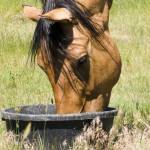Effect of Live Yeast in Equine Diets

Several studies have shown the benefits of adding live yeast products to equine diets. Some early research showed that yeast supplementation produced small but statistically significant increases in fiber digestion. More recent studies have focused on the ability of yeast to prevent digestive upsets.
Any sudden revision in a horse’s diet may result in altered fermentation because of changes in the microbial population in the hindgut. Problems may also occur if horses are fed high levels of soluble carbohydrate, such as starch from grain or fructans from pasture grasses. In these cases, starch overwhelms the digestive ability of the small intestine and large amounts of readily fermentable starch/sugar pass to the large intestine. These situations are sometimes followed by colic, laminitis, and other metabolic disturbances.
Excess sugar and starch accelerate the fermentation process in the hindgut. An overgrowth of bacteria such as Lactobacilli and Streptococci causes lactic acid levels to rise, and a rapid drop in hindgut pH occurs. This leads to the death of normal fiber-degrading bacteria and the production of unusual amounts of gas. Colic often results from these effects, and laminitis may be triggered due to endotoxin release when “good” bacteria are killed.
In the last decade, research has shown that lactic acid levels were lower and cecal pH was higher in horses fed a high-starch diet supplemented with live yeast. Some studies have suggested that numbers of carbohydrate-fermenting, lactic-acid-producing bacteria in feces decreased when yeast was added to the diet of horses challenged with high-concentrate diets. More research is needed to show the exact mechanism by which yeast attenuates problems associated with digestive disturbances caused by overconsumption of starches and sugars in equine diets.








